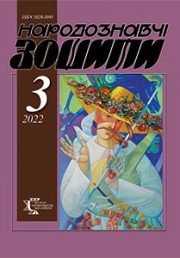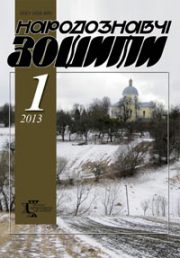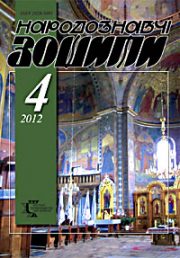The Ethnology Notebooks. 2020. № 4 (154), 841—853
UDK 391:687.38](091)”18/19”
DOI https://doi.org/10.15407/nz2020.04.841
TRADITION OF WOVEN SPRANG BELTS: TECHNIQUE, ETHOLOCAL FEATURES, DECOR
KOZAKEVYCH Olena
- ORCID ID: http://orcid.org/0000-0002-8742-4337
- candidate of arts (Ph. D)
- researcher, Folk Art Department,
- Ethnology Institute of NAS of Ukraine,
- 15, Svobody ave,79000, Lviv, Ukraine,
- Contacts: e-mail: kozakevych.olena@gmail.com
Abstract. Ethnolocal and artistic features of woven sprang belts as an important component of Ukrainian clothing and fabrics are studied. The lack of characteristics of sprang technique, outlining the most noticeable features of the decor, common and different ways of wearing, manufacturing and decoration determined the relevance and novelty of the paper.
Paper purpose — to identify exclusive parameters of sprang technique and technological methods of manufacturing netting belts, to trace the formation of artistic features in the context of socio-cultural and ethno-artistic factors of the late XIX — beginning of XX centuries. The research object is woven sprang belts in the Ukrainian folk clothing complexes, and the subject — unique and universal parameters of their decor. Research techniques to be used are the principle of a systematic approach and comprehensive research. The comparative historical method is applied for study the subject of research and reconstruction method — for research the sprang technique. The art analysis in the study of ethnolocal characteristics and the decor of netting belts is tested. The source base for writing the paper is a scientific research on the chosen topics, author’s field research (2002—2019) and a processing museum and private collections (Kyiv, Lviv, Kolomyia, Rivne, Lutsk etc.).
Results. In the paper technological features of textile sprang technique used in the manufacture sprang belts in Ukraine were characterized. The main centers as well as the tradition transformation of sprang belts in the context of sociocultural and artistic factors during the XX century are determined. Unique and universal features of a dйcor are find out, and the most characteristic colour combinations and ornamental compositions are revealed. Based on the processed items, we can say that this textile technique has become widespread almost throughout Ukraine. However, the changes have taken place in folk clothing and textiles, mainly since the middle of the XX century, have led to the levelling the tradition of wearing sprang belts in everyday life and, consequently, their weaving. It was led to extinction of sprang as weaving technique, but not for its complete destruction. In some areas it was continued, but rather in the context of traditions and rituals or the restoration of folk traditions.
Conclusion. The study of modern practices manufacturing components of folk clothing has shown a lively interest to reconstructions the belts from Polissya, Volyn, Vinnytsia or Stari Kuty since the beginning of the XXI century. This process take place at the level of continuation the local traditions within specify centers (Stari Kuty, Berezovy) or reproduction the items by individual craftswomen or creative teams (regardless of their ethnographic location).
Keywords: belt, technique, decor, sprang, netting structure, decoration, tradition, local features.
Received 1.06.2020
REFERENCES
- Kozakevych, O. (2014). Ukrainian Folk Lace and Knitting Items of the Late XIX — Early XXI Centuries: Historiography of a problem. The Ethnology Notebooks. Art Studies Series, 5 (119), 951—966 [in Ukrainian].
- Kolos, S., Hurhula, I., Lobanovskyi, B., & Poliuskevych, O. (Eds.). (1961). Ukrainian Folk Art. Clothing (Issue 2). Kyiv: Derzhavne Vydavnytstvo Obrazotvorchoho Mystetstva i Muzychnoii Literatury URSR [in Ukrainian].
- Odarchenko, P., & Carynnyk, H. (Eds.). (1992). Ukrainian Folk Costume. Toronto-Philadelphia: World Federation of Ukrainian Women`s Organizations; Folk Art Committee [in Ukrainian].
- Nikolaieva, T. (1996). History of Ukrainian Costume. Kyiv: Lybid [in Ukrainian].
- Nikolaieva, T.O. (2005). Ukrainian Costume. Hope for a Renaissance. Kyiv: Dnipro [in Ukrainian].
- Bilan, M., & Stelmashchuk, H. (2000). Ukrainian Clothing. Lviv: Fenix [in Ukrainian].
- Bilan, M., & Stelmashchuk, H. (2011). Ukrainian Clothing (2th ed.). Lviv: Apriori [in Ukrainian].
- Kosmina, O. (2008). Traditional Clothing of Ukrainians. Forest-stepp. Steppe (Vol. I). Kyiv: Baltia-druk [in Ukrainian].
- Kosmina, O. (2011). Traditional Clothing of Ukrainians. Polissia. Carpathians (Vol. II). Kyiv: Baltia-druk [in Ukrainian].
- Falkowski, J. (1937). The Western Border of the Hutsul Region. Through the Valleys of Prut, Nadvirna`s Bystrzyca, Solotvyno`s Bystrzyca and Јomnica. Lviv [in Polish].
- Zdoroveha, N. (1968). Weaving or Sprang. Folk Art and Ethnography, 2, 68—69 [in Ukrainian].
- Sydorovych, S. (1979). Art Fabrics of UkrSSR Western Regions. Kyiv: Naukova Dumka [in Ukrainian].
- Poliukhovych, Ie. (2004). Sprang Belts Manufacturing in Svarytsevychi Village, Dubrovytsia District, Rivne Region. Proceedings of the Scientific-Practical Conference Dedicated to 30th Anniversary of the Sarny Historical and Ethnographic Museum: Western Polissia: History and Culture (Pp. 148—151). Rivne [in Ukrainian].
- Parkhomenko, T. (2008). Features of Manufacturing Sprang Belts. Belt in Folk Beliefs and Traditions. The Scientific Issues (Vol. VI, pp. 239—245). Rivne [in Ukrainian].
- Ukraiinets, А. (2019). Traditional Clothing of Rivne Region (Vol. 1). Rivne: U Farvateri Istyn [in Ukrainian].
- Ponomar, L.H. (2015). Folk Clothing of Right-Bank Polissia of the Middle of the XIX — the Middle of the XX Centuries. Historical and Ethnographic Atlas. Lexicon. Kyiv: Biznespolihraf [in Ukrainian].
- Kozakevych, O., & Pavliuk, S. (Ed.). (2007). Sprang. The Concise Encyclopedia of Ukrainian Ethnology (Pp. 65—66). Lviv: Afisha [in Ukrainian].
- Kozakevych, O. (2007). Wolyn and Polissia Traditional Knitted Items and Lace Work: Manufacturing Techniques, Typology, Artistic Features. Proceedings of 3th Volyn Regional Scientific and Ethnographic Conference «Rode Nash Krasnyi» (Vol. 24, pp. 116—121). Lutsk [in Ukrainian].
- Kozakevych, O. (2011). Ukrainian Traditional Knitting Items of the End of XIX— XX Centuries: Local Features (According to Western Regions` Materials). Notes Shevchenko Scientific Society. Labor Section of Ethnography and Folklore (Vol. CCLXI (261), pp. 503—524). Lviv[in Ukrainian].
- Kozakevych, O. (2015). The Traditional Knitting any Lace Items in Boyko and Pidhiria Regions of the End of XIX — Early XXI Centuries: Clothing (According to Art Studies Expeditions in 2005—2006) The Ethnology Notebooks, 5 (125), 1127—1149 [in Ukrainian].
- Kozakevych, O. (2018). Tradition of Weaving Belts on Hutsul Region in the XX — the Beginning of the XXI Centuries. The Ethnology Notebooks, 2 (140), 372—384 [in Ukrainian].
- Sydorovych, S.I. (1953). Ukrainian Folk Fabrics (Museum Funds Directory. 1953). Archive of Ethnology Institute of the National Academy of Sciences of Ukraine. F. 1. Op. 2. Case 9. P. 35—39 [in Ukrainian].
- National Museum in Copenhagen. Retrieved from: http://folkcostume.blogspot.com/2011/08/kykai-netted-caps-of-lithuania-and.html (Last accessed: 17.10. 2009).
- Tsourinaki, Sofia. The technique of Sprang: From the Greek headgear to the woolen headdress of Egypt and the belt of Arcadia. Archeology & Arts, 84, 14—20.
- Chernai, I. (1981). Textile Production Among the Dyakovo Culture Tribes (on the Materials of the Seletskoye Settlemant. Soviet Archaeology, 4, 70—87 [in Russian].
- Charewiczowa, L. (1929). Lviv Professional Organizations During the Pre-Partition Poland. Lviv [in Polish].
- Lozinski, W. (1902). Patrycyat and Lviv Bourgeoisie in the XVI and the XVII Centuries. Lviv [in Polish].
- Kozakevych, O., Oliinyk, O, & Fedorchuk, O. (2005). Report of the Art Studies Comprehensive Expedition to Boyko and Lemko Regions. Archive of Ethnology Institute of the National Academy of Sciences of Ukraine. F. 1. Op. 2. Case 530 [in Ukrainian].
- From Above the Bug River. (1897). Lud, 1, 17 [in Ukrainian].
- Kozakevych, O. (2012). Report of the Art Studies Comprehensive Expedition to Western Volyn. Archive of Ethnology Institute of the National Academy of Sciences of Ukraine. F. 1. Op. 2. Case 667 [in Ukrainian].
- MRV, О-6314, Volyn Region.
- MEC (Museum of Ethnography and Crafts of EI of the NASU), EP-76334. Kutyn Village, Zarichne District, Rivne Region.
- MEC, EP-76273. Byshkiv Village, Lubeshiv Dictrict, Volyn Region.
- MEC, EP-76277. Sudche Village, Lubeshiv Dictrict, Volyn Region.
- MEC, EP-20927. Polissia.
- RM (Rivne Museum). Berezhnytsia Village, Dubrovytsia District, Rivne Region.
- RM (Rivne Museum). R2-12, Rivne Region.
- SMV, exposition, to Bukovyna Hutsul Region.
- Herus, L., Nykorak, O., Kozakevych, O., & Shpak, O. (2008). Report of the Art Studies Comprehensive Expedition to Bukovyna Hutsul Region. Archive of Ethnology Institute of the National Academy of Sciences of Ukraine. F. 1. Op. 2. Case 581 [in Ukrainian].
- Kozakevych, O. (2018). Maria Seniuk — Continuer the Tradition of Weaving Belts in Stari Kuty. Proceedings of All-Ukrainian Scientific-Practical Conference: Traditions and Innovations in Modern Design (Pp. 28—33). Ivano-Frankivsk [in Ukrainian].







